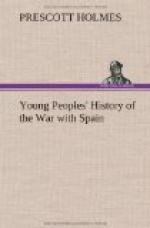During the week that followed that important Sunday, crowds of women, children, and old men; Spaniards, Cubans, and people of other nations, went out of Santiago. They hardly knew where to go. Men who saw that sight said it was pitiful. All the roads leading from Santiago were filled with people and wagons, toiling on to some place of safety. Most of these people had very little food, except the fruit then ripe on the mango-trees, and so had to be fed by our Army and by the Red Cross Society. Ever since General Shafter’s army had landed, it had been feeding the hungry Cubans in the country around Santiago—people who were nearly starved on account of their long war with Spain. Food was scarce in our Army, because there was trouble in landing the supplies sent by the United States, and more trouble in sending the supplies forward to the soldiers. Still, the hungry people from Santiago could not be neglected, and they were given a share of food daily.
And with all those crowds upon the narrow roads from Santiago were many of our wounded soldiers, trying to make their way back to the Red Cross tent at Siboney. There were not enough army wagons to take the wounded from Las Guasimas, El Caney, and San Juan, and they could not all be treated in the field tents. So the men limped and hobbled along as best they could—wounded, sick, feverish—to Siboney, eight miles away. To add to the suffering, this was the wet season in Cuba, and rain fell for hours every day.
During that week of truce, General Shafter arranged with the Spanish general in Santiago for the exchange of Lieutenant Hobson and his crew. Half way between the American camp and the city there was a beautiful ceiba-tree, or silk-cotton tree, so called from the large seed-pods, full of soft, cotton-like stuff. Under this tall, shady tree many important councils were held between the Spanish and American officers. And under this tree, one morning, our officers gave up eight Spanish prisoners in return for Lieutenant Hobson and his men. Our soldiers welcomed these brave fellows with shouts of praise and joy.
[Illustration: The Treaty Tree.]
On July 10th, the truce being ended, our Army and our Navy fired upon Santiago, and kept up the fire on the morning of the next day. Then a new truce was made, for the Spaniards wanted time to consult their Government. General Miles, the Commander-in-Chief of the whole United States Army, arrived and held councils with the Spanish officers. At last the Spaniards agreed to surrender the eastern part of Cuba, and at noon, on July 17th, our flag was hoisted on the governor’s palace in Santiago. Our soldiers took possession of the city, and the citizens, who had gone away in such sorrow, now returned in joy because the United States had taken charge.




